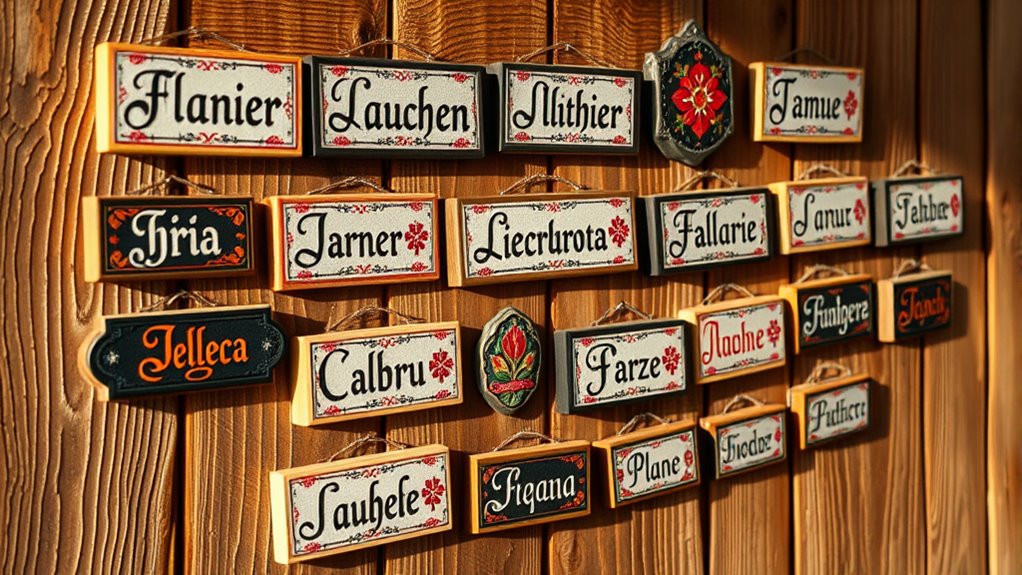Slavic names have deep roots in history, culture, and regional identity, often reflecting traditions and beliefs. Diminutives are formed by adding suffixes like -ka, -ik, or -ko to create softer, more familiar versions of names, used among friends and family to show affection. Variations reveal cultural connections and social bonds, with pronunciation and forms differing across regions. Exploring these patterns and examples helps you understand their rich significance—if you keep exploring, you’ll uncover even more fascinating details.
Key Takeaways
- Slavic names have historical roots reflecting cultural, religious, and regional influences, with variations in pronunciation and meaning.
- Diminutives are formed by adding suffixes like -ka, -ik, or -ko to create softer, more familiar versions of original names.
- Name variations serve as cultural markers, indicating tradition, social bonds, and regional identity within Slavic communities.
- Common diminutive patterns include Ivan → Ivica or Ivanko, and Katarina → Katja or Kati, highlighting regional and personal differences.
- Recognizing suffixes and cultural context helps in understanding and appropriately using Slavic nicknames, fostering social connection and respect.
The Origins and Meanings of Slavic Names

Have you ever wondered where Slavic names come from and what they mean? The origins of Slavic names are deeply rooted in historical influences that shaped their development over centuries. These names often reflect ancient traditions, religious beliefs, and local customs, offering insight into the culture’s values. Regional variations in name pronunciation also play a role, with different countries and communities adding unique twists to common names. For example, a name like Ivan may sound slightly different in Russia compared to Bulgaria or Serbia. These differences highlight how geography and history influence naming practices. Overall, Slavic names carry stories from the past, blending linguistic roots with regional identities, making each name a reflection of both history and local culture.
How Diminutives Are Formed and Used

Diminutives are formed by modifying the original Slavic names through specific linguistic patterns, making them more familiar, affectionate, or informal. You’ll notice that name formation rules often involve adding suffixes like -ka, -ik, or -ko, or altering the root of the name slightly. These patterns help create diminutive forms that sound softer and more personal. In daily life, diminutive usage is common when speaking with friends, family, or children, as it conveys closeness and warmth. For example, a person named Aleksander might be called Aleksa or Sashka among loved ones. Using diminutives is a natural part of Slavic communication, reflecting affection and familiarity while also making names easier to pronounce in informal settings. Additionally, Kia Tuning customization can be tailored to match personal preferences, much like how diminutives personalize names.
Cultural Significance of Name Variations

Names and their variations carry deep cultural meaning in Slavic communities, serving as more than just personal identifiers. They reflect tradition, social bonds, and respect. Nickname etiquette is important; using a familiar diminutive shows closeness and affection, while formal names maintain respect in official settings. Variations in names reveal cultural identity through names, linking individuals to their heritage and community. Choosing the right form demonstrates understanding of social norms and personal connections. These name variations often carry emotional weight, symbolizing relationships and belonging. They also help preserve cultural roots amid modernization. By respecting nickname etiquette and recognizing the significance of name variations, you honor the social fabric and traditions that define Slavic cultural identity through names. Additionally, understanding the transformative power of decluttering can help communities maintain organized and meaningful cultural artifacts, reinforcing their shared heritage.
Common Slavic Names and Their Diminutive Forms

Ever wonder how familiar forms of common Slavic names reflect cultural warmth and social bonds? These diminutive forms often originate from historical influences on name variations, shaped over centuries by interactions, migrations, and language changes. For example, the name Ivan becomes Ivanko or Ivica, while Katarina turns into Katja or Kati. Regional differences in nicknames also play a role; in some areas, shorter forms are more affectionate, while others favor formal versions. Diminutives serve as expressions of closeness and familiarity, making social interactions more personal. Understanding these common names and their diminutive forms helps you appreciate the rich cultural tapestry behind everyday names, revealing how history and regional nuances influence the way Slavic communities connect through language. Additionally, linguistic evolution has played a significant role in shaping the diverse nicknaming practices observed across different Slavic regions.
Tips for Understanding and Using Slavic Nicknames

To effectively understand and use Slavic nicknames, it helps to familiarize yourself with the common patterns and cultural contexts behind them. Pay attention to how nicknames in everyday conversation often stem from the original name but are shortened or altered with affectionate suffixes like -ko, -ek, or -ka. Knowing regional differences in diminutive forms is key, as they vary across countries and communities. For example, a nickname that’s common in Russia might differ in Poland or Serbia. Listening carefully to how locals address each other can give you clues about the appropriate diminutive to use. Recognizing name derivation patterns can also aid in understanding the origins and appropriateness of specific nicknames. Remember, using the right nickname shows respect for cultural nuances and helps you connect more naturally in social interactions.
Frequently Asked Questions
How Do Slavic Names Differ Across Various Slavic Countries?
You’ll notice that Slavic names differ across countries due to regional variations and historical influences. For example, Russian names often feature patronymics and diminutives, while Croatian names reflect Latin roots, and Polish names incorporate unique suffixes. These differences stem from historical factors like migrations, religious influences, and cultural exchanges. By understanding these variations, you can better appreciate the rich diversity of Slavic naming conventions across the region.
Are There Specific Rules for Creating Diminutives for Female Names?
Imagine your friend Elena, and you want to create a diminutive for her name. You follow diminutive formation rules, which often involve adding feminine name suffixes like -ka or -sha. For female names, these rules are quite consistent across Slavic languages, usually involving suffixes like -ka, -sha, or -ya. These suffixes help form affectionate or familiar diminutives, making your nickname warm and personalized.
What Role Do Religious Influences Play in Slavic Naming Practices?
Religious influences profoundly shape Slavic naming practices. You’ll notice religious symbolism in name choices, often honoring saints or biblical figures. The influence of church traditions guides naming customs, like celebrating saints’ feast days or choosing names from religious texts. These practices reflect deep-rooted spiritual values, blending cultural identity with faith. As a result, many names carry religious significance, reinforcing community bonds and spiritual heritage within Slavic societies.
Can Diminutives Be Used Formally in Slavic Cultures?
They say, “Don’t judge a book by its cover,” but in Slavic cultures, diminutives rarely serve as formal address. You typically use full names for official or respectful settings, while diminutives are reserved for familiar or informal interactions. Diminutive usage etiquette emphasizes warmth and closeness, so using them in formal settings can seem disrespectful or overly familiar. Stick to formal address customs for official occasions, and reserve diminutives for friends and family.
How Have Modern Trends Affected Traditional Slavic Naming Conventions?
Modern trends have profoundly impacted traditional Slavic naming conventions by challenging cultural preservation amidst globalization. You might notice more diverse or international names replacing classic ones, yet some people still cherish traditional names and diminutives for cultural identity. While globalization impacts naming choices, many actively preserve their heritage by choosing traditional names or using diminutives in respectful contexts, balancing modern influences with the desire to maintain cultural roots.
Conclusion
Now that you’ve uncovered the fascinating world of Slavic names and diminutives, you’re just beginning to see their true depth. Behind every nickname lies a story, a connection, a hidden meaning waiting to be discovered. Will you look beyond the surface and explore the rich cultural tapestry they reveal? The next time you hear a Slavic name, remember—there’s more than meets the eye. The real story might just be waiting for you to uncover it.









